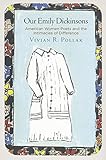Our Emily Dickinsons : American Women Poets and the Intimacies of Difference / Vivian R. Pollak.
Material type: TextSeries: Haney Foundation SeriesPublisher: Philadelphia : University of Pennsylvania Press, [2016]Copyright date: ©2017Description: 1 online resource (368 p.) : 31 illusContent type:
TextSeries: Haney Foundation SeriesPublisher: Philadelphia : University of Pennsylvania Press, [2016]Copyright date: ©2017Description: 1 online resource (368 p.) : 31 illusContent type: - 9780812248449
- 9780812293227
- American poetry -- Women authors -- History and criticism
- Authors and readers -- United States -- History
- Difference (Philosophy) in literature
- Intimacy (Psychology) in literature
- Women and literature -- United States -- History
- Women poets, American -- 20th century
- Cultural Studies
- Literature
- Poetry
- LITERARY CRITICISM / Women Authors
- 811/.4 23
- PS1541.Z5 P584 2017eb
- online - DeGruyter
- Issued also in print.
| Item type | Current library | Call number | URL | Status | Notes | Barcode | |
|---|---|---|---|---|---|---|---|
 eBook
eBook
|
Biblioteca "Angelicum" Pont. Univ. S.Tommaso d'Aquino Nuvola online | online - DeGruyter (Browse shelf(Opens below)) | Online access | Not for loan (Accesso limitato) | Accesso per gli utenti autorizzati / Access for authorized users | (dgr)9780812293227 |
Frontmatter -- Contents -- Abbreviations -- Introduction. Dickinson and the Demands of Intimacy -- Chapter 1. Helen Hunt Jackson and Dickinson's Personal Publics -- Chapter 2. Mabel Loomis Todd and Dickinson's Art of Sincerity -- Chapter 3. ''The Wholesomeness of the Life'': Marianne Moore's Unartificial Dickinson -- Chapter 4. Moore, Plath, Hughes, and ''The Literary Life'' -- Chapter 5. Plath's Dickinson: On Not Stopping for Death -- Chapter 6. Elizabeth Bishop and the U.S.A. Schools of Writing -- Conclusion. Dickinson and the Demands of Difference -- Notes -- Works Cited -- Index of Dickinson's Poems and Letters -- General Index -- Acknowledgments
restricted access online access with authorization star
http://purl.org/coar/access_right/c_16ec
For Vivian R. Pollak, Emily Dickinson's work is an extended meditation on the risks of social, psychological, and aesthetic difference that would be taken up by the generations of women poets who followed her. She situates Dickinson's originality in relation to her nineteenth-century audiences, including poet, novelist, and Indian rights activist Helen Hunt Jackson and her controversial first editor, Mabel Loomis Todd, and traces the emergence of competing versions of a brilliant but troubled Dickinson in the twentieth century, especially in the writings of Marianne Moore, Sylvia Plath, and Elizabeth Bishop.Pollak reveals the wide range of emotions exhibited by women poets toward Dickinson's achievement and chronicles how their attitudes toward her changed over time. She contends, however, that they consistently use Dickinson to clarify personal and professional battles of their own. Reading poems, letters, diaries, journals, interviews, drafts of published and unpublished work, and other historically specific primary sources, Pollak tracks nineteenth- and twentieth-century women poets' ambivalence toward a literary tradition that overvalued lyric's inwardness and undervalued the power of social connection.Our Emily Dickinsons places Dickinson's life and work within the context of larger debates about gender, sexuality, and literary authority in America and complicates the connections between creative expression, authorial biography, audience reception, and literary genealogy.
Issued also in print.
Mode of access: Internet via World Wide Web.
In English.
Description based on online resource; title from PDF title page (publisher's Web site, viewed 26. Aug 2020)


